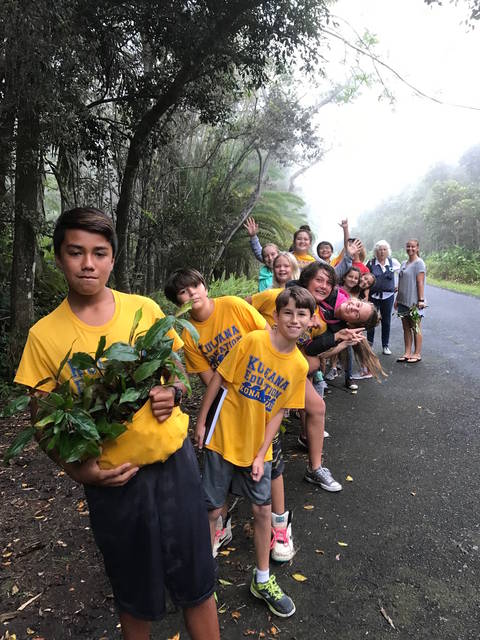As the days get warmer and the sun is strong it is a great time to enjoy Hawaii’s flowering trees like the Royal Poinciana, Tabebuia, Plumeria, Cassia Shower and many more. We also have many of the world’s 500-plus species
As the days get warmer and the sun is strong it is a great time to enjoy Hawaii’s flowering trees like the Royal Poinciana, Tabebuia, Plumeria, Cassia Shower and many more. We also have many of the world’s 500-plus species of ginger beginning to make a show now. It is also the beginning of hurricane season. Hopefully, we will enjoy our trees without having to deal with damaging storms.
There was a time when forests covered much of the lands that are now grass, savannah and desert. Early Polynesians brought with them pigs, rats and jungle fowl. The impact on our endemic loulu palm forests was devastating, but with the introduction of grazing animals in the late 18th century, our forests really began to shrink. The vast koa forests of the Kohala mountains, mauka Kona and East Hawaii are now mere remnants of their past glory. Now the threat of rapid ohia death fungus may further decimate our forests.
Loss of forests affects the climate making hot hotter, dry dryer and wind windier. Even areas like Hilo experience extremes of flood and drought when forests in the area are removed.
Luckily for us, some folks know the value of forests and windbreaks. Our progressive ranchers are planting some koa and valuable timber trees at higher elevations.
Then there are groups like the Outdoor Circles, 4-H, Scouts and Lions clubs that are doing what they can to reforest.
Well-planned areas like Mauna Lani, Waikoloa, Kukio, Hualalai, Kohanaiki, North Kohala and Mauna Kea Resorts are literally being transformed into tropical oases. But all this is just not enough.
So how can we as individuals help beautify and make our environments more enjoyable? People in areas like Kaloko Mauka, Kona, have gotten involved in the Forestry Division’s Forest Stewardship program. Nonprofit groups like Nature Conservancy and Hawaiian Islands Land Trust are giving landowners the opportunity to protect our forests. For more information on how the Land Trust can help, contact Janet Britt, Hawaii Island director, at 769-4343. The Land Trust does tours of the projects throughout the year. If interested, there is a tour scheduled for 1:30 p.m. on Wednesday, May 31, to the Kona Cloud Forest Sanctuary. For reservations, call Janet.
Even folks with small lots can help. By planting trees in our little pieces of paradise, we can actually change the microclimate and make our communities several degrees cooler in the summer. If you place your trees just right, you can even create a garden climate that is milder during cool, windy periods. It’s really interesting when you expand these basic principles. What happens when everyone in your neighborhood or community plants shade trees?
You can actually change the climate over fairly large areas. Foresters have research data that show reforestation may increase local rainfall and modify temperature extremes. By the way, urban reforestation is what is happening when lots of folks in a neighborhood or town plant trees.
Now let’s look at the tree planting from another angle. Visitors bring millions of dollars to Hawaii each year. Our sunny winter skies are a big attraction. It used to be that our beaches and tropical woodlands were part of that appeal. Now with urban sprawl on some of our best beaches, our main salvation from endless asphalt alleys is abundant landscaping.
Planting trees to give shade and beautify our communities isn’t the complete answer, but it can help. Shopping is miserable when streets are barren and parking lots are hot and uncomfortable. Hotels, restaurants and gas stations that are attractively landscaped with shade trees, shrubs and grass attract customers. Even grocery and department stores are finding that landscaping pays off.
In tree planting activities, remember, proper planting is important, as well as a knowledge of the tree’s requirements. Maintenance is the limiting factor as to whether street planting is practical. Be sure to choose trees that fit the space in which they must grow. A visit to the Keauhou or Lanihau shopping centers and Kailua Village along Alii Drive is a pleasure because of the efforts to landscape. Of course, we need to improve even our best examples of landscaping as we become more sensitive to the regreening of our Islands.
In some new developments, underground utilities are installed. This allows freedom from wires and poles. In such well-planned tracts, street side shade trees may be planted to minimize the negative impact of asphalt and concrete. Where utility lines are overhead, it is important to plant trees that stay small, no more than 15 feet tall in most cases. This will minimize the problem of maintaining utility services. There are many good books to help in choosing the right trees to plant. Sunset’s New Western Garden Book covers all the climate zones we have here even if one lives at sea level or at 6,000 feet. Extension agents at the University of Hawaii Cooperative Extension Service in Kainaliu can assist you as well.
In Hawaii, we have a wide variety of plants, both native and non-native. Those plants that arrived in Hawaii before the first human contact are considered natives. Those plants that arrived with the aid of Polynesians, Europeans, Chinese, Japanese or other groups of people settling here are considered introduced. Therefore, we have a wide variety for beauty and as a food source for both humans and our wildlife such as birds. By keeping abundant vegetation as an integral part of our human communities, we actually find a constant healthy connection with our natural world.



